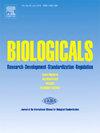评估与使用体内和体外疫苗效力测试有关的风险。
IF 1.5
4区 生物学
Q4 BIOCHEMICAL RESEARCH METHODS
引用次数: 0
摘要
一个多世纪以来,动物(体内)效价试验一直被用于支持疫苗开发和质量检测。这是当时最先进科学的遗产。然而,知识和技术的进步为在开发过程中使用更灵敏的检测方法提供了机会,并用体外替代品取代了传统的动物试验。再加上替代、减少和改进(3R)以及质量源于设计(QbD)等举措,使行业和监管机构共同采用了先进的疫苗控制策略。本文从风险的角度探讨了在疫苗技术开发和控制中使用动物的历史和现状,以及用体外替代品取代动物的情况。一个首要的风险是使用替代效力测定法测试的疫苗无法保护目标受体。这可以从检测方法与疫苗作用机制的关联以及将疫苗引入患者群体的规则(如规格)的角度来解决。人们通常理解的分析精确度等概念在风险评估中起着一定作用,因为它影响着检测灵敏度,而检测灵敏度是由生产过程中或疫苗保质期内的变化引起的有意义的产品变化所决定的。在评估将多浓度(或稀释)体内试验减少为单一浓度试验等解决方案时,应考虑到这一点。虽然在疫苗研发中使用动物不会完全消失,但模式必须从体内试验转向体内模型。为帮助确保成功,与引入体外替代品相关的原则和实践需要行业、监管机构、药典和支持组织之间的全球合作。本文章由计算机程序翻译,如有差异,请以英文原文为准。
Assessment of the risks associated with the use of in vivo versus in vitro potency tests for vaccines
Animal (in vivo) potency tests have been utilized for over a century in support of vaccine development and for quality testing. This is a legacy of the best science at the time of their introduction. Advances in knowledge and technology, however, have provided opportunities to utilize more sensitive assays during development and replace legacy animal tests with in vitro alternatives. This coupled with initiatives such as replacement, reduction, and refinement (the 3-R's) and quality by design (QbD) have brought industry and regulators together in the introduction of advanced vaccine control strategies.
This article examines historical and current uses of animals in vaccines technical development and control, and their replacement with in vitro alternatives from a risk point of view. An overarching risk is that a vaccine tested with an alternative potency assay fails to protect its target recipient. This can be addressed from the perspective of the assay's association with the vaccine mechanism of action, and the rules used to introduce the vaccine into the patient population (e.g., specifications). Commonly understood concepts such as analytical precision play a role in risk evaluation based on its impact on the sensitivity of a test to detect meaningful product changes caused by variations in manufacture or over a vaccine's shelf life. This should be considered when evaluating solutions such as the reduction of multi-concentration (or dilution) in vivo assays to a single concentration test. While the use of animals in vaccine development will not go away all together, the paradigm must shift from in vivo tests to in vivo models. To help ensure success, principles and practices related to introduction of in vitro alternatives require global collaboration among industry, regulators, pharmacopeias, and supporting organizations.
求助全文
通过发布文献求助,成功后即可免费获取论文全文。
去求助
来源期刊

Biologicals
生物-生化研究方法
CiteScore
3.70
自引率
0.00%
发文量
39
审稿时长
48 days
期刊介绍:
Biologicals provides a modern and multidisciplinary international forum for news, debate, and original research on all aspects of biologicals used in human and veterinary medicine. The journal publishes original papers, reviews, and letters relevant to the development, production, quality control, and standardization of biological derived from both novel and established biotechnologies. Special issues are produced to reflect topics of particular international interest and concern.Three types of papers are welcome: original research reports, short papers, and review articles. The journal will also publish comments and letters to the editor, book reviews, meeting reports and information on regulatory issues.
 求助内容:
求助内容: 应助结果提醒方式:
应助结果提醒方式:


